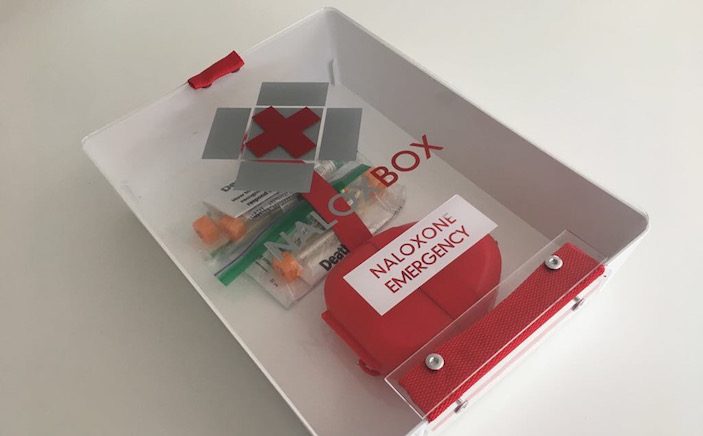Emergency physician aims to make life-saving doses of naloxone more accessible.
If you want to stop fires from spreading, keep fire extinguishers handy. If you want to prevent death by heart attack, you place defibrillators at strategic points of population. If you want to reduce opiate overdose deaths, you create the NaloxBox—and hope it becomes as commonplace as the other two.
The idea is to make naloxone more readily available in areas at high risk for overdose deaths. Geoff Capraro, an emergency physician and university professor in Rhode Island, teamed up with Claudia Rebola of the Rhode Island School of Design to produce the NaloxBox, an easy-access emergency medicine kit containing four doses of the drug, instructions on how to administer it, and a mask to deliver rescue breathes. The boxes, which cost about $100 each to make, are designed with a clear red door, Velcro latch, an elastic strap to accommodate injectable or nasal forms of the drug, and an electronic mechanism that sends a text message when the box is opened, so whoever monitors the box can easily document incidents and replenish it as needed.
“The original design was more elaborate, but we realized we needed to simplify it,” said Capraro. “So, we opted for components you can buy easily.”
Armed with the first of two grants from the Rhode Island Department of Health and significant help from the PONI overdose prevention program at Miriam Hospital, the two produced the first 48 kits—you guessed it, in a garage—this spring. This summer, they installed them at Amos House and seven similar facilities that serve the homeless, impoverished, and people dealing with addiction.
“It’s obviously a big problem, and we know it can takes six minutes or more [for an ambulance]to get there,” said Capraro. “So, we came up with this to help with this one sliver of the problem- building capacity for bystander rescuers to save a life in advance of the arrival of EMS.”
While six states—Alaska, Arizona, Florida, Maryland, Massachusetts, and Virginia—have officially declared opioid emergences, Naloxone is not readily available in every state. Thirty-five states allow it to be purchased without a prescription, though one still has to go to a qualified pharmacy.
For now, Capraro’s expectation is that trained workers at the Rhode Island shelters will administer an intermuscular formation of the drug. But the next step will be to target other areas with the nasal version so that Good Samaritans can intervene without any medical training.
“With the second grant, we’re looking to transition into more public places with high foot traffic,” said Capraro. “It would be great if we had enough penetration that there’s a general awareness that naloxone saves lives and anyone can take action.”
The team just fixed a glitch with the smart latch, and Capraro is participating in a social entrepreneurship program this fall to learn how to create the organizational structure to support a much bigger roll out. “I’m not a business person,” he says. “My partner Dr. Rebola is working on a redesign that will enable mass production, to try scale production and distribution quickly,” he said.
An Associated Press story on the NaloxBox has already attracted a burst of media attention. So much so that plans are already in the works for Ohio and Ottawa this Fall, and Capraro speaks of a “big effort” already underway within Philadelphia libraries as well.








